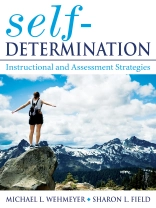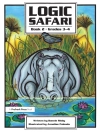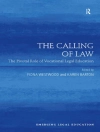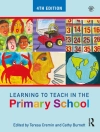‘There is not available a more comprehensive book in the area of self-determination.’
—Melinda Pierson, Department of Special Education
California State University, Fullerton
‘Unique because it provides direction for teaching and supporting self-determined behavior across all age groups and also within the general education classroom and curricula.’
—Marianne Mooney, Senior Research Associate
Trans Cen, Inc., Post-Secondary Learning and Careers
Give students with disabilities powerful tools for success in school and in life!
Michael Wehmeyer and Sharon Field present research-proven instructional strategies that empower special needs students at all grade levels to make their own decisions.
Self-Determination offers detailed and current practitioner-oriented approaches in combination with extensive teacher reproducibles—all within the context of inclusion, standards-based reform, and access to the general curriculum. Linked to the IDEA requirement for individualized transition plans, this user-friendly resource assists practitioners in teaching the skills necessary for making decisions about employment, job skills, further schooling, and independent living. Educators will discover how to:
- Encourage students to become their own advocates by practicing assertive behavior
- Use needs-assessment techniques to determine the level of instruction required for each student
- Teach effective choice making, problem solving, and goal setting
- Support both families and fellow educators in their efforts to teach self-determination skills
Special education teachers, general educators, and administrators will find this handbook an invaluable guide for helping students establish their own goals and plan for a strong and healthy future!
Table of Content
Preface
Acknowledgements
About the Authors
1. Self-Determination: What Is It and Why Is It Important to Students With Disabilities?
Self-Determination: What Is It?
A Functional Model of Self-Determination
A Five-Step Model of Self-Determination
Self-Determination: Why Is It Important to Students With Disabilities?
Impact of Promoting Component Elements of Self-Determined Behavior
Impact of Promoting Self-Determination
2. Self-Determination in the Era of Standards-Based Reform
Promoting Self-Determination in the General Education Curriculum
Self-Determination Content in General Education Standards
Self-Determination and Curriculum Modifications
Infusing Instruction Into the General Education Curriculum Planning
Curriculum Content
3. Educational Planning and Student Involvement
IEP Planning, Access to the General Education Curriculum, and Self-Determination
Supplementary Aids and Services
Specially Designed Instruction
Other Educational Needs
Self-Advocacy and Student Involvement in Educational Planning
Promoting Self-Advocacy
Student Involvement in Educational Planning
4. Schoolwide and Classroom Ecological Interventions
Quality Indicators of Programmatic Efforts
Quality Indicator #1: Knowledge, Skills, and Attitudes for Self-Determination Are Addressed in the Curriculum, in Family Support Programs, and in Staff Development
Quality Indicator #2: Students, Parents, and Staff Are Involved Participants in Individualized Educational Decision Making and Planning
Quality Indicator #3: Students, Families, Faculty, and Staff Are Provided With Opportunities for Choice
Quality Indicator #4: Students, Families, Faculty and Staff Are Encouraged to Take Appropriate Risks
Quality Indicator #5: Supportive Relationsips Are Encouraged
Quality Indicator #6: Accommodations and Supports for Individual Needs Are Provided
Quality Indicator #7: Students, Families, and Staff Have the Opportunity to Express Themselves and Be Understood
Quality Indicator #8: Consequences for Actions Are Predictable
Quality Indicator #9: Self-Determination Is Modeled Throughout the School Environment
5. Teacher-Directed Instructional Strategies
Learning Process Strategies
Modeling and Mentors
Cooperative Learning Groups
Coaching
Behavioral Strategies
Teaching Component Elements of Self-Determined Behavior
Teaching Goal Setting and Attainment
Teaching Problem Solving
Teaching Decision Making
Fostering Self-Awareness and Self-Knowledge
Promoting Choice Making
Attribution Retraining
Curricular Materials
6. Student-Directed Learning and Peer-Mediated Instructional Strategies
Student-Directed Learning Strategies
Antecedent Cue Regulation
Self-Monitoring, Self-Evaluation, and Self-Reinforcement
Self-Instruction
Multiple Strategy Use
The Self-Determined Learning Model of Instruction
Peer-Mediated Learning Strategies
7. Assessing Student Needs and and Evaluation Program
Assessing Instructional Needs in Self-Determination
The Arc′s Self-Determination Scale
Self-Determination Assessment Battery
The AIR Self-Determination Scale
Program Evaluation
Empowerment Evaluation
8. Family Support for Self-Determination
How Families Impact Student Self-Determination
Strategies and Resouces to Help Family Members Learn About Self-Determination
Family Support for Self-Determination: Tips and Tools
Sharing Stories About Self-Determination
Making the Most of Teachable Moments
Providing a Positive Role Model of Self-Determination
9. Nurturing the Self-Determination of Teachers
What Do Educators Need to Know to Be Self-Determined in Their Work?
What Can Teachers Do to Build and Nurture Their Self-Determination?
Resource A. Self Determination Quality Indicators Assessment Tool
Resource B. The Arc′s Self-Determination Scale
References
Index
About the author
Sharon Field, Ed.D., is Professor (Research) and Co-director of the Center for Self-Determination and Transition in the College of Education at Wayne State University. Her areas of specialization include self-determination, transition and life skills, and applied positive psychological practices. She has directed several federally funded transition and self-determination projects. Through these projects she developed, with Dr. Alan Hoffman, a model of self-determination and the Steps to Self-Determination curriculum and, with Drs. Alan Hoffman and Shlomo Sawilowsky, a self-determination assessment battery. She has written extensively on self-determination for persons with and without disabilities. Her work has included development of materials and strategies to promote self-determination at the early childhood, elementary, secondary and post-secondary levels. She is also the lead author of The Self-Determined Educator, a set of instructional modules for use in initial preparation and staff development settings designed to promote self-determination for teachers and Self-Determined Parenting , an instructional support program for parents. She has direct service experience in schools as a special education teacher, job placement specialist and administrator. Dr. Field earned her Master’s degree in Special Education from the University of Wisconsin-Whitewater and her Ed.D. in Educational Policy, Governance and Administration from the University of Washington.












